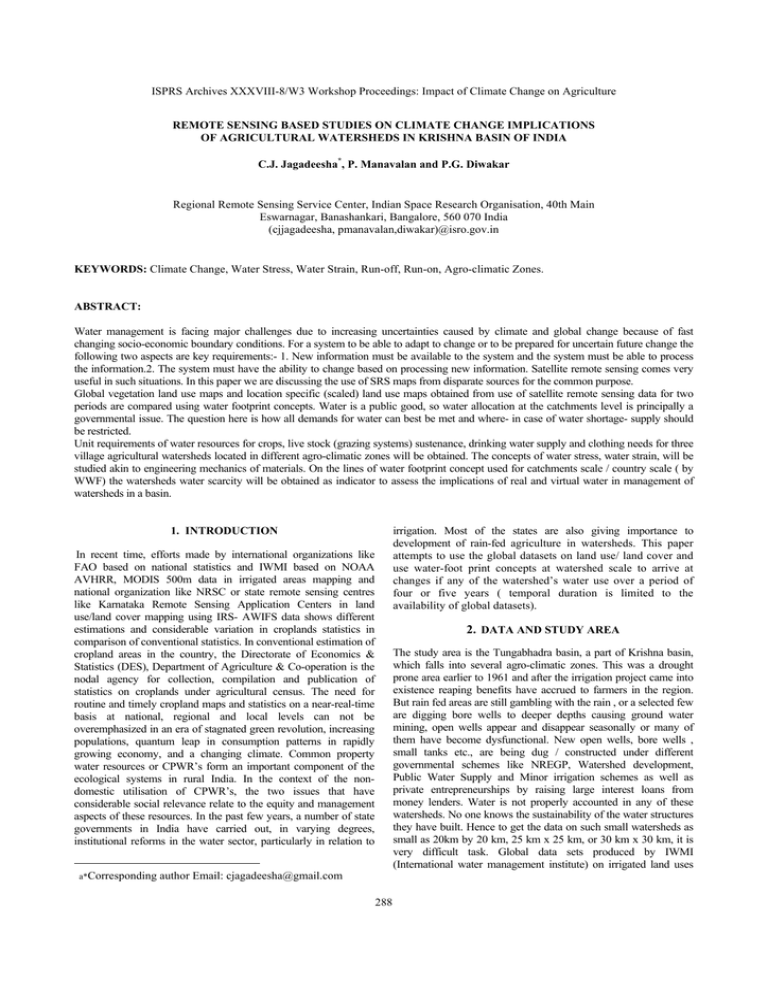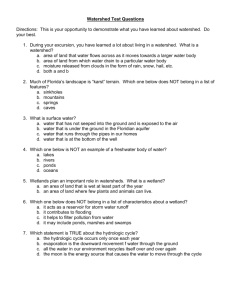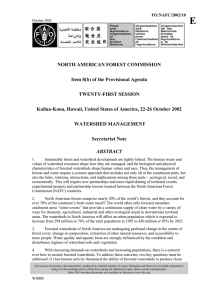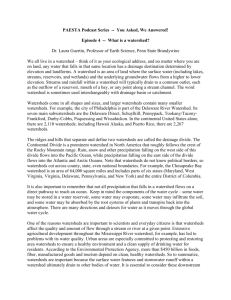ISPRS Archives XXXVIII-8/W3 Workshop Proceedings: Impact of Climate Change on... REMOTE SENSING BASED STUDIES ON CLIMATE CHANGE IMPLICATIONS
advertisement

ISPRS Archives XXXVIII-8/W3 Workshop Proceedings: Impact of Climate Change on Agriculture REMOTE SENSING BASED STUDIES ON CLIMATE CHANGE IMPLICATIONS OF AGRICULTURAL WATERSHEDS IN KRISHNA BASIN OF INDIA C.J. Jagadeesha*, P. Manavalan and P.G. Diwakar Regional Remote Sensing Service Center, Indian Space Research Organisation, 40th Main Eswarnagar, Banashankari, Bangalore, 560 070 India (cjjagadeesha, pmanavalan,diwakar)@isro.gov.in KEYWORDS: Climate Change, Water Stress, Water Strain, Run-off, Run-on, Agro-climatic Zones. ABSTRACT: Water management is facing major challenges due to increasing uncertainties caused by climate and global change because of fast changing socio-economic boundary conditions. For a system to be able to adapt to change or to be prepared for uncertain future change the following two aspects are key requirements:- 1. New information must be available to the system and the system must be able to process the information.2. The system must have the ability to change based on processing new information. Satellite remote sensing comes very useful in such situations. In this paper we are discussing the use of SRS maps from disparate sources for the common purpose. Global vegetation land use maps and location specific (scaled) land use maps obtained from use of satellite remote sensing data for two periods are compared using water footprint concepts. Water is a public good, so water allocation at the catchments level is principally a governmental issue. The question here is how all demands for water can best be met and where- in case of water shortage- supply should be restricted. Unit requirements of water resources for crops, live stock (grazing systems) sustenance, drinking water supply and clothing needs for three village agricultural watersheds located in different agro-climatic zones will be obtained. The concepts of water stress, water strain, will be studied akin to engineering mechanics of materials. On the lines of water footprint concept used for catchments scale / country scale ( by WWF) the watersheds water scarcity will be obtained as indicator to assess the implications of real and virtual water in management of watersheds in a basin. irrigation. Most of the states are also giving importance to development of rain-fed agriculture in watersheds. This paper attempts to use the global datasets on land use/ land cover and use water-foot print concepts at watershed scale to arrive at changes if any of the watershed’s water use over a period of four or five years ( temporal duration is limited to the availability of global datasets). 1. INTRODUCTION In recent time, efforts made by international organizations like FAO based on national statistics and IWMI based on NOAA AVHRR, MODIS 500m data in irrigated areas mapping and national organization like NRSC or state remote sensing centres like Karnataka Remote Sensing Application Centers in land use/land cover mapping using IRS- AWIFS data shows different estimations and considerable variation in croplands statistics in comparison of conventional statistics. In conventional estimation of cropland areas in the country, the Directorate of Economics & Statistics (DES), Department of Agriculture & Co-operation is the nodal agency for collection, compilation and publication of statistics on croplands under agricultural census. The need for routine and timely cropland maps and statistics on a near-real-time basis at national, regional and local levels can not be overemphasized in an era of stagnated green revolution, increasing populations, quantum leap in consumption patterns in rapidly growing economy, and a changing climate. Common property water resources or CPWR’s form an important component of the ecological systems in rural India. In the context of the nondomestic utilisation of CPWR’s, the two issues that have considerable social relevance relate to the equity and management aspects of these resources. In the past few years, a number of state governments in India have carried out, in varying degrees, institutional reforms in the water sector, particularly in relation to a*Corresponding 2. DATA AND STUDY AREA The study area is the Tungabhadra basin, a part of Krishna basin, which falls into several agro-climatic zones. This was a drought prone area earlier to 1961 and after the irrigation project came into existence reaping benefits have accrued to farmers in the region. But rain fed areas are still gambling with the rain , or a selected few are digging bore wells to deeper depths causing ground water mining, open wells appear and disappear seasonally or many of them have become dysfunctional. New open wells, bore wells , small tanks etc., are being dug / constructed under different governmental schemes like NREGP, Watershed development, Public Water Supply and Minor irrigation schemes as well as private entrepreneurships by raising large interest loans from money lenders. Water is not properly accounted in any of these watersheds. No one knows the sustainability of the water structures they have built. Hence to get the data on such small watersheds as small as 20km by 20 km, 25 km x 25 km, or 30 km x 30 km, it is very difficult task. Global data sets produced by IWMI (International water management institute) on irrigated land uses author Email: cjagadeesha@gmail.com 288 ISPRS Archives XXXVIII-8/W3 Workshop Proceedings: Impact of Climate Change on Agriculture (1997- 1998 year of satellite data) of the Tungabhadra basin and available in web portal of IWMI are one dataset. The land use data depicting Khariff, Rabi and double crops etc areas by Karnataka State remote sensing applications center, Bangalore, India for the entire Karnataka state watershed- wise is another dataset used in this study. The year of satellite data acquisition was 2002- 2003. The study area for the purpose of this paper is limited to three watersheds which fall in northern dry zone, southern transition zone and northern transition zones which are there types out of ten different agro-climatic zones of the state of Karnataka. At all India level the agro-climatic zones are 15 in number in entire India. Karnataka state region falls in 3 out of 15 agro-climatic zones in India viz., WHg (Western Plateau and Hills), DP (Southern Plateau and Hills), WC (West Coast Plains and Hills) for most of its area. The categorization existence of CPWRS in agro-climatic zones of EHg, EG, TD and DP at all India level makes us understand the possibility of existence or otherwise of water-markets. 3. WATER FOOT PRINT CALCULATIONS The principle of virtual water is really simple. Water is required for the production of food such as cereals, vegetables, meat and dairy products. The amount of water consumed in the production process of a product is called the “virtual water” contained in the product (Allan J.A.) For example , to produce 1 kg of wheat we need about 1000 litres of water. For meat we need about 5-10 times as much ! The vitual water content of a product tells something about the environmental impact of consuming this product. Knowing the virtual water content of products creates awareness of the water volumes needed to produce the various goods, thus providing an idea of which goods impact the most on the water system and where water savings best could be made. Hoekstra and Hung (2002) have introduced the concept of the water foot print (Hoekstra and Hung) The sum of national (watershed) water use and net virtual water import is defined as the “water foot print” of a country (watershed) The water foot print can be a strong tool to show people their impact on the natural resources. Awareness of ones individual water foot print would simulate a more careful use of water. The crop water requirements (in metre cube per hectare) (CropWat Model) for various crops, the actual crops yields (ton per hectare) in 1999 (FAOSTAT), and specific water demands (metre cube per tonne) in 1999 are used to obtain all the values in table 3 and table 4. Table 1 gives land use/ land cover obtained from IWMI portal. Table 2 gives land use land cover obtained from KSRSAC, Bangalore watershed database (2002) using IRS satellite images. Suitable grouping of land use/cover classes was carried out to bring uniformity of data for use in water foot print calculations. 289 ISPRS Archives XXXVIII-8/W3 Workshop Proceedings: Impact of Climate Change on Agriculture Table 3: Specific water demand using Global data sets for Karnataka: IWMI/GIAM Project Table 1: Land Use / Land Cover using Global data sets for Karnataka: IWMI/GIAM Project Table 2: Land Use / Land Cover using Global data sets for Karnataka:KSRSAC-Micro watersheds Atlas Project Table 4: Specific water demand using Global data sets for Karnataka: KSRSAC-Micro watersheds Atlas Project 290 ISPRS Archives XXXVIII-8/W3 Workshop Proceedings: Impact of Climate Change on Agriculture Water strain, a phrase introduced to mean the deficit in water resources needed to satisfy the needs. If the water availability is Wa, and the total need for water is Wn , the water strain is equal to (Wa – Wn) / Wn, negative for shortage and positive for surplus. This definition ties in with terminology used in engineering mechanics where the strain is defined as the elongation / shortening of the bar in our above example divided by the original length. See table 6 for details. 4. WATER REQUIREMENTS Water requirement for drinking and sanitation is calculated as per water supply position existing in Karnataka. Water requirement for textiles/clothes (5 pairs of cotton clothes each pair weighing 2 kg is assumed to be used by villagers annually) and grazing systems livestock sustenance water is taken from FAOSTAT database. Then table 5 is prepared. Table 5: Water requirement for Drinking, Sanitation & Clothes for Human Population and Grazing systems livestock sustenance. 5. WATER AVAILABILITY Water availability for one year is taken as the normal rainfall (average of the past thirty or so years) falling uniformly distributed between the rainfall isohyets. Run off is calculated as per Strange’s average catchments criteria (Subramanya K) for all the watersheds. Run on is calculated after due considerations for daily evaporation during spell of rainy days. See table 6 for details. Row 1 of table 6 gives water availability (WA) for all the watersheds. Row 2 the run off volumes in million meter cube. Row 3 run on volumes (available in vadose zones, saturated zones and ground water)Row 5 is obtained from table 3 and table 4 mainly and to which an additional requirement as is obtained in table 5 is added for drinking water supply , sanitation , clothes and grazing systems live stock sustenance. In row 6 , water scarcity is calculated as the ratio of water use to water availability. Table 6: Water Stress and Water Strain in Watersheds 7. RESULTS AND DISCUSSIONS The table 6 shows most of the results. The following can be said: a. The water stress, water strain, water scarcity, run off, run on ratios , can be used as indicators of water use of a watershed to even as small as 20 kmx 20km(say) b. Indicators like water stress and water strain point to ground water mining possibilities when large number of people use unit flow of water and have negative values for water strain. For ex 1: watershed 4D4C2 (LB Tungabhadra) in North transition zone is in severe water use scenario. This watershed is in fact situated in the near distance of back waters of Tungabhadra project’s reservoir which irrigates more than six lakhs of hectares downstream. For ex 2: The water strain of watershed 4D4B1 (Meruru4) in North Dry Zone tends to mine ground water in 2002 relative to 1998. 6. WATER STRESS AND WATER STRAIN Water stress, usually used to describe the degree to which water resources are short of meeting the needs of the population of a given region / watershed. In this paper M.J.Haddadin’s definition of water stress is followed. (Haddadin). Water stress as the number of people per unit flow of indigenous water, the unit flow being taken as one million cubic meters per year. As such water stress has a quantitative value expressed in people per unit flow. This definition draws analogy from the science of engineering mechanics where the stress in a cross-section of a bar as a result of an axial force acting on the bar is defined as the force per unit area. c. C. An analysis like these done in this paper can easily be extrapolated to understand water markets as is analyzed in IDPAD 291 ISPRS Archives XXXVIII-8/W3 Workshop Proceedings: Impact of Climate Change on Agriculture to international crop trade. Value of Water research report series No.11, IHE.the Netherlands. studies (Arabinda Misra) in India. These studies use NSSO data and ICSSRIDPAD research data. Crop Wat model (http://www.fao.org) ACKNOWLEDGEMENTS FAOSTAT database (http://www.fao.org) The first author wishes to place on record the support given by Karnataka State Remote Sensing Applications Center for providing watershed wise maps and statistics data. Scientists Ashok Reddy and Laxmikanth of KSRSAC need special mention. Subramanya, K., 2008.Engineering Hydrology, Tat McGraw Hill, Third Edition, New Delhi. The authors thank Director, RRSSC, ISRO HQs Dr.YVNK Murthy for his constant encouragement. Haddadin, M.J., 2003.Exogenous water: A conduit to globalization of water resources-in Proceedings of the International Expert Meeting on Virtual water trade edited by Hoekstra. A.Y. Value of Water Research Report Series No.12, DHF, Netherlands. REFERENCES Allan, J.A., 1998. Virtual water: strategic resource. Global solutions to regional deficits. Ground water, 36(4), pp546- 546 Arabinda Mishra, Nayantara Nayak, Rucha Ghate, Pranab Mukhopadhyaya,2008, IDPAD Common property resources, TERI, New Delhi. Hoekstra, A.Y., and Hung, P.Q., 2002. Virtual water trade: a quantification of virtual water flows between nations in relation 292






